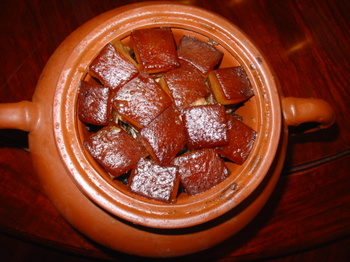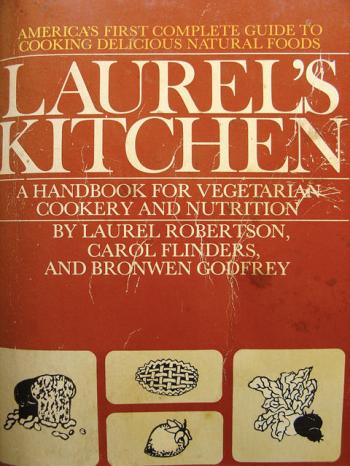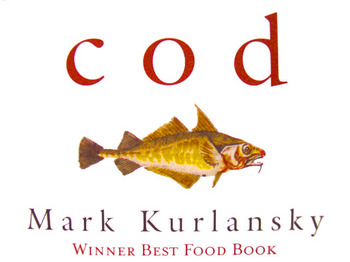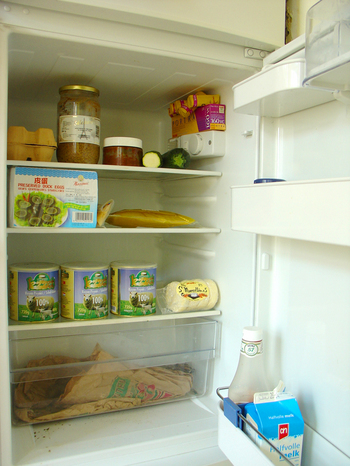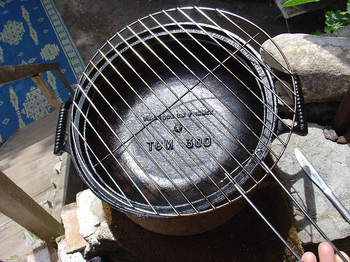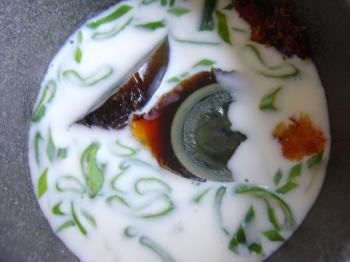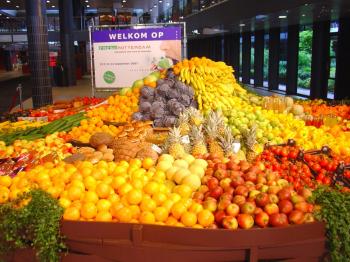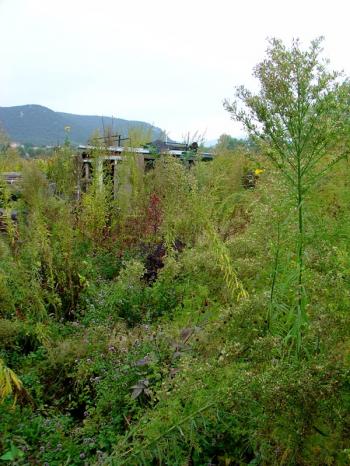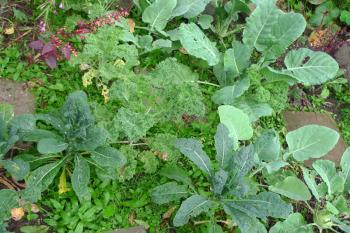Not piss poor,
fertilized with pee
September 13, 2009
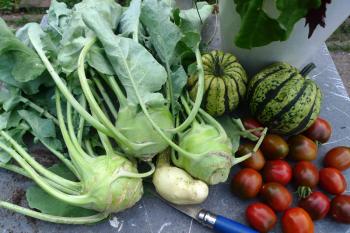
Didn’t go to the farmers’ market this Saturday
One of the reasons I gave my Amsterdam kitchen garden the name Slim Pickins was to show that even a postage stamp-sized garden with a relatively little crop could serve up a surprising amount of food. But the real reason was that it had piss poor soil and I always thought the garden looked scrawny. I used to blame the slow rate of growth on the location, but visits to many local organic farms and especially to the nearby school gardens had made it painfully clear that the anemia of my produce had nothing to do with living so close to the Polar Circle. Well maintained school gardens right in the middle of the city were lush because they had great soil.
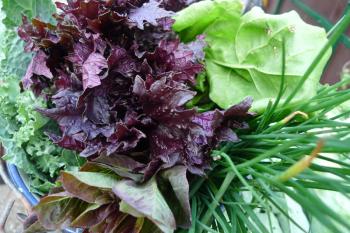
I’ll be chewing this cud all week
In the hope of increasing soil nutrients, I grew the green manures that were hugely successful in the Occitanian kitchen garden. But at Slim Pickins, the alfalfa, vetch, fenugreek and phacelia didn’t burgeon and produce huge mats of biomass like they did in the south, in a large part due to the blasted ground conditions. I’d been thinking about asking a farmer I knew if he’d bring me a load of composted manure, but I never ended up going ahead with this because I just don’t like the idea of importing large volumes of additives from afar. Searching for a solution closer to home, I considered making a worm composter and biking the castings over one recycled yoghurt container at a time, but there were already so many worms casting away in the garden that this plan just seemed bass-ackwards.
By the time I had returned to my garden in August I had basically resigned myself to a mediocre harvest. But two weeks ago I starting bumping into links about fertilizing with urine. I knew that pee was nutrient rich, balanced in nitrogen, potassium and phosphorus, and I had no problem with it in the animal manure. Why it hadn’t occurred to me to try using my own I’ll just chalk up to a deeply ingrained societal taboo against humanure. One YouTube video and 3 articles later and suddenly urine fertilizer seemed like a painless experiment with a material both abundant and free. I decided to give it a go. I might have even been giddy, biking over all those recycled yoghurt containers filled with pee.
Following instructions, in a big bucket I diluted (DILUTE! DILUTE! OK!) 1 part fresh pee to 10 parts Amsterdam tap water, gave it a stir and poured it on my soil, trying to avoid splashing the leaves. It’s possible that there was some more giddiness at this point. Recycled yoghurt containers empty, I left the garden and returned one week later.
AND…
WOWWY!
KAZOWWY!
And now with jazz hands!
Pity I didn’t make scientific-style before and after pictures but you’ll have to believe me when I say that the results were striking. In one week’s time all of the plants suddenly produced a great deal of leaf, and the leaf-colour seemed to have deepened considerably. All of the plants, but especially the climbing ones (calabas and hokkaido), appear to have undergone an enormous growth spurt. This happened during a waning moon, and with ever cooling temperatures. At home in the window box my spindly vervain and green shiso that had always resembled bonsais, suddenly filled out in their pot.
Possibly you are thinking, “Hey Nut-Job, OY VEY, what about the SMELL, what about the TASTE?” I can report that there is no urine or amonia smell at all, even on my indoor plants. (When I saw the difference in just a few days on the herbs, I had to try it indoors.) Some of the net-lit studies suggest that insects (like aphids) can taste the difference and stay away. I can’t taste … any… urine. Well, how do you know what urine tastes like? I don’t know, how do you don’t? What? I don’t know. Shut up.
And to get back to the reason I did this in the first place, the Slim Pickins kitchen garden produced a two bike-bag bumper crop and it looks like next week will be the same. I had such an abundant harvest (chard, kohlrabi, kale, cavalo nero, various leafy herbs, tomatoes, chives) that I didn’t need to go to the Farmers’ Market. Although I don’t think the folks at Organic Farm the Knotwilg will have to get another day job, the results in my garden after just one week of urine fertilizing are impressive.
In case you were planning on coming over for a nibble of some Slim Pickins goodness, I’m harvesting on Saturdays and fertilizing on Mondays. You’ll probably pray for rain.
-
Urine Charge Every day we urinate away nutrients–nutrients that could grow food, fiber, flowers and even fuel! Human urine contains nutrients in the form of nitrogen, which plants love, and it’s usually pathogen free.
Online version of the Humanure Handbook by Joseph Jenkins, humanure expert
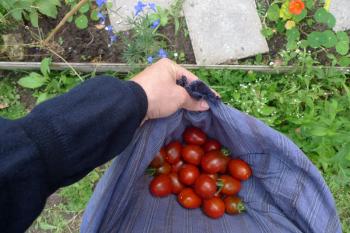
The tomato that keeps on giving
debra at 21:16 | Comments (4) | post to del.icio.us
Foodscape Schilderswijk,
Den Haag’s CPUF
September 8, 2009
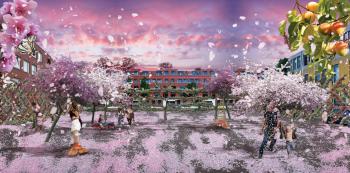
A scenario for planting espallier-style fruit trees in the Schilderswijk. Illustration by Jacques Abelman.
As part of STROOM Den Haag’s (Centre for Art and Architecture) multi-year programme FOODPRINT, I have been commissioned to design a foodscape. Actually I am designing a Continuous Productive Urban Foodscape, or CPUF, a spinoff acronym based on colleagues Bohn & Viljoen Architect’s CPUL, in which the ‘L’ word is landscape. Foodscape Schilderswijk explores the potential for integrating urban agriculture (UA) into existing social and green infrastructure in this Den Haag burrough. Unique to this project is an aesthetic, permaculture approach to cultivation design utilizing vertical and interstitial spaces as a place where fruit and vegetables can be grown, and befitting the overall design of the public domain. Most importantly I am collaborating with existing social infrastructure such as schools, community centres, and other municipal agencies. The local partners will be powerful agents in the design process.
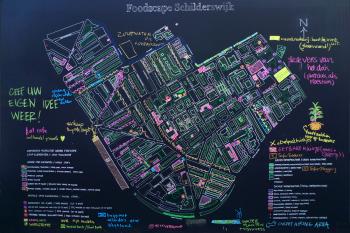
A hand drawn chalkboard map of the Schilderswijk burrough. Jacques and I used permanent markers, exhibition visitors filled in suggestions to the planning in chalk.
The project presupposes local commitment to knitting UA and adjacent infrastructures both social and green into one coherent plan. This means implementing a spatially contiguous scenario into which primarily existing facilities, activities, programming, and platforms for (food-related) cultural content are connected to diverse forms of edible landscape architecture. Baby Bakeries, DIY Oven Museums made by school children, Roti Lounges for the so-called ‘idle youth’ or maybe even their mums, and Free Kitchens are just as much a part of the Foodscape as Herb Lawns, Salade Façades, Espalier fruit fences and Pumpkin Tunnels.
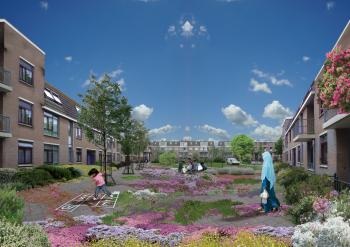
An over-the-top-scenario for planting an herbal groundcover in a de-paved pedestrian zone. Illustration by Jacques Abelman.
Once implemented these components will connect the Schilderswijk’s dots of green and brown, and include stainless steel, cast iron and community initiatives as part of the Foodscape plan. This project is currently ending its research phase and entering the ‘let’s see which local partners want to get married’-phase. With the help of these partners, I hope to complete the initial design in November 2009.
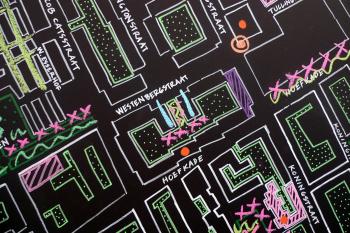
Map detail of the ‘first marriage’, an espallier-style fruit orchard in a collective garden.
A permanent feature of many cities in developing countries, UA?s biggest challenge in Northern European cities like Den Haag will be its integration into civic planning and infrastructure such that city dwellers can access its benefits. UA?s second biggest challenge will be to sow and grow it?s own cultural heritage that enables it to forge a sumptuously visual identity resplendent with vital programming and content relevant to existing (and future) Den Haag communities.STROOM Den Haag Centre for Art and Architecture programme for FOODPRINT, about building sustainable food production in the Den Haag.
Culiblog review of Bohn & Viljoen Architects book CPUL, COntinuous Productive Urban Landscapes
debra at 20:21 | Comments (2) | post to del.icio.us

